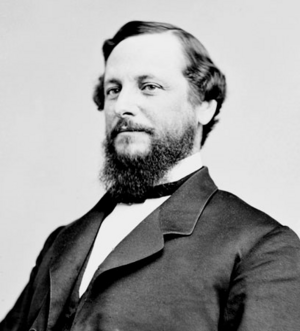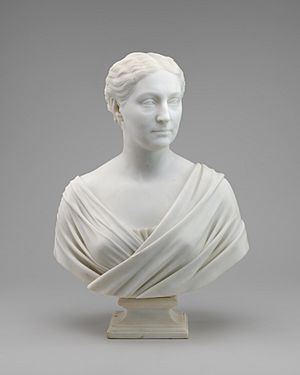George H. Pendleton facts for kids
Quick facts for kids
George H. Pendleton
|
|
|---|---|
 |
|
| United States Ambassador to Germany | |
| In office June 21, 1885 – April 25, 1889 |
|
| President | Grover Cleveland Benjamin Harrison |
| Preceded by | John A. Kasson |
| Succeeded by | William Phelps |
| Chairman of the Senate Democratic Caucus | |
| In office March 4, 1881 – March 3, 1885 |
|
| Preceded by | William A. Wallace |
| Succeeded by | James B. Beck |
| United States Senator from Ohio |
|
| In office March 4, 1879 – March 3, 1885 |
|
| Preceded by | Stanley Matthews |
| Succeeded by | Henry B. Payne |
| Member of the U.S. House of Representatives from Ohio's 1st district |
|
| In office March 4, 1857 – March 3, 1865 |
|
| Preceded by | Timothy C. Day |
| Succeeded by | Benjamin Eggleston |
| Member of the Ohio Senate from the 1st district |
|
| In office January 2, 1854 – January 6, 1856 Served with John Schiff, William Converse |
|
| Preceded by | Edwin Armstrong Adam Riddle John Vattier |
| Succeeded by | Stanley Matthews George Holmes William Converse |
| Personal details | |
| Born |
George Hunt Pendleton
July 19, 1825 Cincinnati, Ohio, U.S. |
| Died | November 24, 1889 (aged 64) Brussels, Belgium |
| Political party | Democratic |
| Spouse | Alice Key |
| Parents | Jane Frances Hunt Pendleton Nathanael Greene Pendleton |
| Relatives | Francis Scott Key (father-in-law) |
| Education | University of Cincinnati Heidelberg University |
George Hunt Pendleton (born July 19, 1825 – died November 24, 1889) was an American politician and lawyer. He represented Ohio in both the House of Representatives and the Senate. He was also the Democratic candidate for Vice President of the United States in 1864.
Pendleton studied at the University of Cincinnati and Heidelberg University in Europe. He then became a lawyer in his hometown of Cincinnati, Ohio. His father, Nathanael Greene Pendleton, was a Congressman. His father-in-law was Francis Scott Key, who wrote "The Star-Spangled Banner."
After serving in the Ohio Senate, Pendleton was elected to the U.S. House of Representatives. During the American Civil War, he was a leader of the "Copperheads." These were Democrats who wanted peace with the Confederacy. After the war, he voted against the Thirteenth Amendment, which ended slavery.
In 1864, the Democratic Party nominated George B. McClellan for president and Pendleton for vice president. They lost to Abraham Lincoln and Andrew Johnson. Pendleton also lost his re-election to Congress that year. He later ran for president in 1868 but was not chosen.
Pendleton became president of the Kentucky Central Railroad for a time. He returned to politics in 1879 when he was elected to the U.S. Senate. While in the Senate, he helped pass the important Pendleton Civil Service Reform Act of 1883. This law made sure that many government jobs were given based on skill, not political connections. This act made him less popular in Ohio, and he was not re-elected. President Grover Cleveland then made him the ambassador to Germany. He served in this role until 1889 and died later that year.
Contents
Early Life and Education
George Hunt Pendleton was born in Cincinnati, Ohio, on July 19, 1825. His parents were Jane Frances Hunt Pendleton and Nathanael Greene Pendleton. His father was a U.S. Representative.
He went to local schools and Cincinnati College. He also studied at the University of Heidelberg in Germany. Pendleton then studied law and became a lawyer in 1847. He started his law practice in Cincinnati.
Political Career Highlights
Pendleton was elected to the Ohio Senate and served from 1854 to 1856. His father had also been a member of the Ohio Senate. In 1857, Pendleton was elected to the United States House of Representatives. He served there for eight years, until 1865.
During his time in the House, he was part of a group that handled the impeachment of a U.S. judge named West H. Humphreys in 1862.
In the 1850s, Pendleton did not support laws that would stop slavery in the western United States. During the Civil War, he was a leader of the "peace" group within his party. These were known as Copperheads. They wanted to make peace with the Southern states. He voted against the Thirteenth Amendment, which officially ended slavery.
National Politics and Elections
Pendleton was a well-known "Peace Democrat." In the 1864 United States presidential election, he was chosen as the vice-presidential running mate for George B. McClellan. McClellan wanted to continue the war, but Pendleton wanted peace. This was an unusual pairing.
McClellan was 37 and Pendleton was 39. They were the youngest major party presidential ticket ever nominated in the U.S. Their opponents were President Abraham Lincoln and Andrew Johnson. McClellan and Pendleton lost the election. They received about 45% of the popular vote.
Because he was running for vice president, Pendleton did not try to be re-elected to Congress. The Democrat who ran for his seat lost to a Republican.
Time Out of Office
After leaving Congress, Pendleton ran for his old House seat in 1866 but lost. In 1868, he tried to get the Democratic Party's nomination for president. He led for many votes but eventually lost to Horatio Seymour. The next year, he ran for Governor of Ohio but lost again. This time, he lost to Rutherford B. Hayes.
After these losses, Pendleton took a break from politics. In 1869, he became the president of the Kentucky Central Railroad.
Return to Politics
In 1879, Pendleton made a comeback in politics. He was elected as a Democrat to the United States Senate. He served one term, from 1881 to 1885. During this time, he was also the Chairman of the Senate Democratic Conference.
After President James A. Garfield was assassinated in 1881, Pendleton helped create and pass an important law. This law is known as the Pendleton Civil Service Reform Act of 1883. This act required people to take exams to get many government jobs. It helped end the system where jobs were given based on political favors, not skill.
However, passing this act cost Pendleton political support. Many members of his own party liked the old system of giving jobs to friends. Because of this, he was not chosen to run for a second term in the Senate.
Later Life and Legacy
After leaving the Senate, President Grover Cleveland appointed Pendleton as the ambassador to Germany. He served in this role until April 1889. Five months later, while returning to the United States, he died in Brussels, Belgium.
Pendleton believed that the Democratic Party was the best way for ordinary Americans to influence government. He was committed to the idea of states' rights and limited government, which was common for Democrats at the time. His desire to create more opportunities for regular Americans led him to support civil service reform.
Family Life

In 1846, George Pendleton married Mary Alicia Key (1824–1886). She was the daughter of Francis Scott Key. Francis Scott Key was a lawyer and poet famous for writing "The Star-Spangled Banner," the U.S. national anthem.
George and Alicia had five children:
- Sarah Pendleton (born around 1846)
- Francis Key Pendleton (1850–1930), who became well-known in New York society.
- Mary Lloyd Pendleton (1852–1929)
- Jane Francis Pendleton (1860–1950)
- George Hunt Pendleton (1863–1868), who died young.
George H. Pendleton died in Brussels, Belgium, on November 24, 1889, after suffering a stroke. He is buried in Spring Grove Cemetery in Cincinnati, Ohio.
Memorials
The city of Pendleton, Oregon, is named after George H. Pendleton.
His home in Cincinnati, the George Hunt Pendleton House, is a National Historic Landmark. It was added to the National Register of Historic Places in 1966.
See also
 In Spanish: George H. Pendleton para niños
In Spanish: George H. Pendleton para niños



